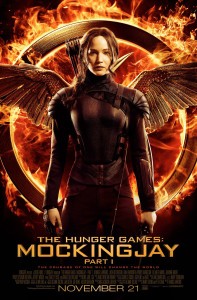 This trend is execrable. Harry Potter and the Deathly Hallows: Part 1 and 2. The Hobbit 1, 2, and 3. The Twilight Saga: Breaking Dawn–Part 1 and 2.* Hollywood, like a dairy farmer with cold hands, has gripped tightly to whatever dangling teat it can find, wringing every drop of funds from the American cash cow. And, like a Holstein, I shuffled into the stall this weekend and dangled.
This trend is execrable. Harry Potter and the Deathly Hallows: Part 1 and 2. The Hobbit 1, 2, and 3. The Twilight Saga: Breaking Dawn–Part 1 and 2.* Hollywood, like a dairy farmer with cold hands, has gripped tightly to whatever dangling teat it can find, wringing every drop of funds from the American cash cow. And, like a Holstein, I shuffled into the stall this weekend and dangled.
The Hunger Games: Mockingjay–Part 1, like its predecessors referenced above, is a beloved franchise being sliced and diced for financial purposes. What is already thin material, is made thinner by spreading it over four hours. Action is minimized. Plots are elongated. Holding patterns are established. In Harry Potter, audiences were forced to endure the never-ending tent. In Mockingjay–Part 1, they endure the bunker. Such is the nature of this cynical profiteering. Francis Lawrence, the director, has a nearly impossible job and it shows.
The film, as it stands, is not terrible. The plot picks up at the end of Catching Fire, with Katniss (Jennifer Lawrence) having been whisked away from the Quarter Quell and into the bowels of District 13. She reconnects with Plutarch Heavensbee (Philip Seymour Hoffman), who is now the propaganda minister for President Alma Coin (Julianne Moore), the leader of the now not so incipient rebellion against Panem. The pair needs Katniss as an image to rally the other districts. President Snow (Donald Sutherland), the leader of Panem, has his own media tool, Katniss’ paramour, Peeta (Josh Hutcherson). The film largely unspools from this foundation.
The strengths are few and simple. Jennifer Lawrence is a fine actress. Without her ability to make sitting in a bunker, conflicted, somewhat interesting, Mockingjay–Part 1 would be only mocked. Some of the scenes outside of the bunker are moving, especially as they depict the human costs of the growing rebellion, which stands in contrast to Panem’s escalating ruthlessness.
The weaknesses, outside of the structure, deserve mention. The interminable love triangle between Katniss, Peeta, and Gale (Liam Hemsworth) persists painfully. The most interesting characters, outside of Lawrence, are given little screen-time to shine. Haymitch (Woody Harrelson) and Effie Trinket (Elizabeth Banks) are literally and figuratively muted. Neither Alma Coin, nor her potentially tyrannical regime in District 13, are explained well enough to understand, especially for those who have not read the books.
The Hunger Games: Mockingjay–Part 1 suffers as an incomplete experience, like a four course meal that ends prematurely. Even if delicious, soup and salad are rarely enough to leave one satisfied. Mockingjay–Part 1 is not filling as it stands alone. Perhaps once viewed alongside the conclusion, it will improve.
Final Grade: 1/3 Eggheads
*For the record, I have neither seen nor read anything Twilight related and I don’t see that changing anytime soon. It does fit the trend here of splitting single books into multiple films, though I cannot say for sure the cinematic experience would have been much improved by a single film to cover the last book.
 Bert Wheeler
Bert Wheeler
 Jeff Haymond
Jeff Haymond
 Marc Clauson
Marc Clauson
 Mark Caleb Smith
Mark Caleb Smith
 Tom Mach
Tom Mach